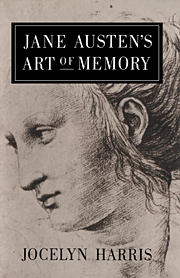Book contents
- Frontmatter
- Contents
- Preface
- 1 Northanger Abbey
- 2 The return to Richardson
- 3 Sense and Sensibility
- 4 Pride and Prejudice
- 5 Mansfield Park
- 6 Emma
- 7 Persuasion
- Conclusion: ‘Nothing can come of nothing’
- Appendix 1 The History of Sir Charles Grandison
- Appendix 2 Sir Charles Grandison in the juvenilia
- Notes
- Bibliography
- Index
2 - The return to Richardson
Published online by Cambridge University Press: 18 August 2009
- Frontmatter
- Contents
- Preface
- 1 Northanger Abbey
- 2 The return to Richardson
- 3 Sense and Sensibility
- 4 Pride and Prejudice
- 5 Mansfield Park
- 6 Emma
- 7 Persuasion
- Conclusion: ‘Nothing can come of nothing’
- Appendix 1 The History of Sir Charles Grandison
- Appendix 2 Sir Charles Grandison in the juvenilia
- Notes
- Bibliography
- Index
Summary
Northanger Abbey, says Jane Austen in her ‘Advertisement’ of 1816, was the novel first ‘finished’. Drafted in 1798–9, it was completed and offered to a publisher as ‘Susan’ in 1803. Jane Austen probably only retouched it in the years before it was published posthumously with Persuasion in 1817. But about 1795 she had written an epistolary form of Sense and Sensibility called ‘Elinor and Marianne', and in 1796–7 composed ‘First Impressions’, the original of Pride and Prejudice. Sense and Sensibility, it is thought, was revised in 1809–11 before publication in 1811, Pride and Prejudice was radically revised about 1812 before publication in 1813, and Mansfield Park was written in 1811–13 before publication in 1814 (see A. Walton Litz's ‘Chronology of composition’). It is decidedly odd therefore that although Northanger Abbey shows little trace of Richardson except for references to his Rambler and to Miss Andrews, the three other novels depend upon him so pervasively. Critics are often bewildered by Jane Austen's fondness for Richardson, Lord David Cecil in the introduction to jane Austen's ‘Sir Charles Grandison’, for instance, and even Richardsonians must wonder why Jane Austen, who sharpened her wits upon him in the juvenilia (see Appendix 2) and rejected his epistolary method when she revised ‘Elinor and Marianne’ and ‘First Impressions’, might turn back to him in her maturity.
- Type
- Chapter
- Information
- Jane Austen's Art of Memory , pp. 34 - 47Publisher: Cambridge University PressPrint publication year: 1989



